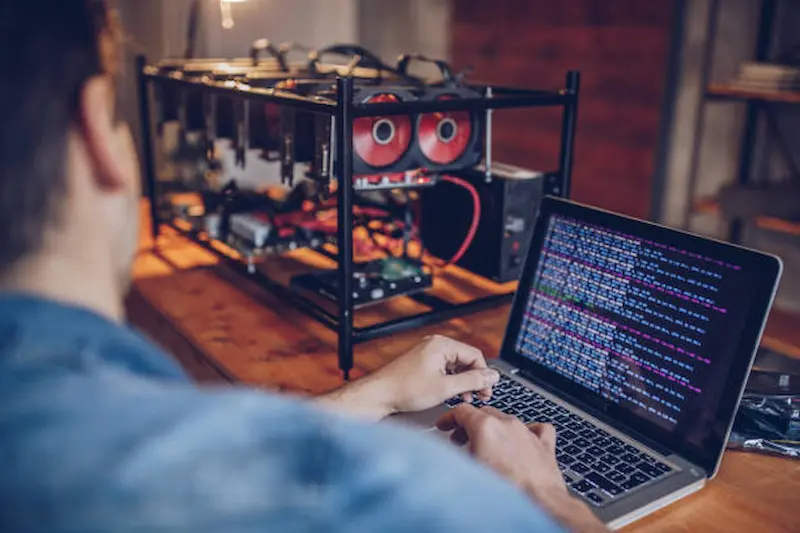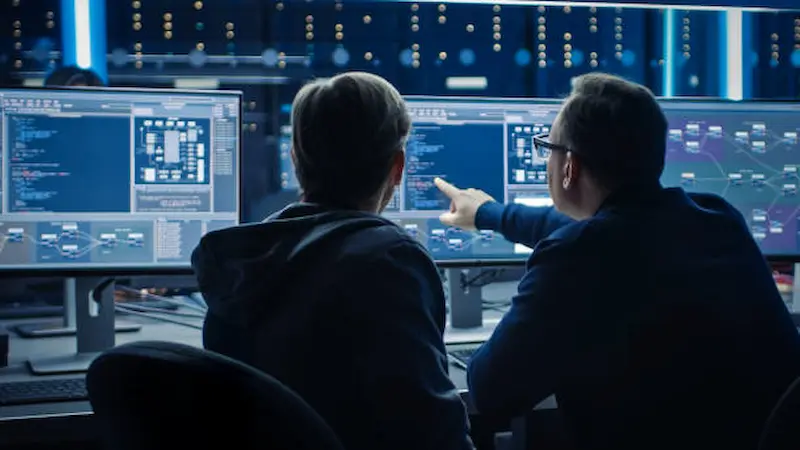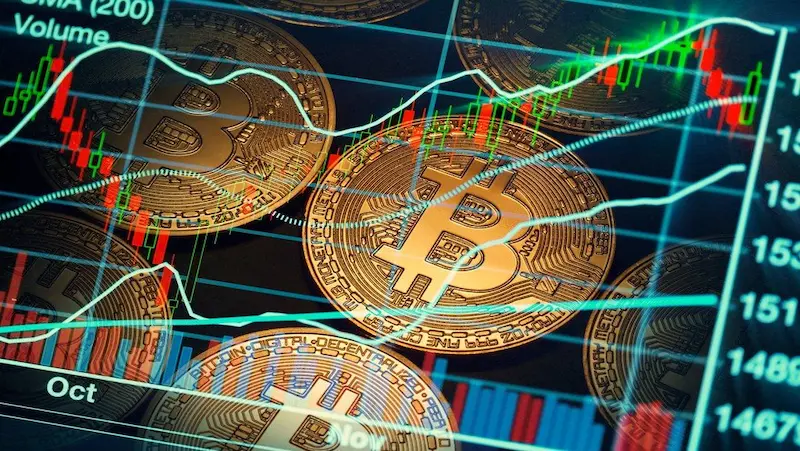Bitcoin mining is the process of validating and adding transactions to the blockchain on the Bitcoin network. Miners employ processing power to solve complicated mathematical riddles in order to secure the network and earn rewards in the form of newly minted Bitcoins. Bitcoin mining is essential for ensuring the network’s security and integrity. It decentralizes power, prevents double spending, and ensures Bitcoin scarcity and supply. It is the cornerstone of the whole Bitcoin ecosystem, making it a critical component in the cryptocurrency industry.
In this blog, we will delve into the fascinating world of Bitcoin mining, where powerful computers solve complex mathematical puzzles to secure the Bitcoin network and earn rewards in the form of newly minted bitcoins.
Table of contents
- The Basics of Bitcoin
- Blockchain Technology
- Mining as a Pillar of Bitcoin
- Bitcoin Mining Process
- Cryptographic Puzzle: Proof of Work
- Mining Difficulty
- Setting Up Your Mining Operation
- Joining a Mining Pool
- Risks and Challenges
- Alternatives to Bitcoin Mining
- Mining Security
- Conclusion
- Frequently Asked Questions ( FAQs )
The Basics of Bitcoin

A. Understanding Bitcoin
Bitcoin functions as a decentralized digital currency, running on blockchain technology. It stands apart from conventional currencies as it lacks centralized control by governments or banks. Instead, a network of computers validates Bitcoin transactions, creating a transparent and censorship-resistant system. Users safeguard their Bitcoin holdings in digital wallets, with all transactions meticulously recorded on a public ledger, ensuring both security and transparency in the Bitcoin ecosystem.
B. How is Bitcoin Created?
Bitcoins are created through a process called “mining.” Miners use powerful computers to solve complex mathematical puzzles, adding new transactions to the blockchain and earning Bitcoins as a reward. This process not only creates new coins but also secures the network. The total supply of Bitcoin is capped at 21 million, making it deflationary and potentially valuable as a store of value. Understanding these fundamental aspects is crucial before venturing into the world of Bitcoin and cryptocurrency investing.
Blockchain Technology

A. What is Blockchain?
Blockchain is a distributed ledger technology that records transactions across a network of computers, much like fostering positive thinking for kids can create a supportive environment. It consists of a chain of blocks, each containing a set of transactions. What makes blockchain unique is its decentralization, transparency, and security. Once a transaction is added to a block, it becomes immutable, making it virtually tamper-proof. This technology’s reliability ensures trust in various applications, just as positive thinking fosters resilience and confidence in children.
B. How Does Blockchain Work?
Blockchain relies on a consensus mechanism among network participants to validate and add new transactions. These transactions are grouped into blocks, and each block references the previous one, forming a chronological chain. Cryptography ensures data security and decentralized nodes maintain the network. This technology finds applications beyond cryptocurrencies, including supply chain management, voting systems, and more, due to its trust-building capabilities and resilience against fraud. Understanding the blockchain is pivotal in exploring its diverse applications in various industries.
Mining as a Pillar of Bitcoin

A. Role of Miners in Bitcoin
Miners play a pivotal role in the Bitcoin network. They validate transactions, securing the blockchain and preventing double-spending. Miners compete to solve complex mathematical puzzles, ensuring the authenticity of transactions and adding them to the blockchain.
B. Mining Rewards
Miners are rewarded with newly created Bitcoins and transaction fees for their efforts. This incentivizes participation and provides a mechanism for the issuance of new Bitcoins, crucial for the network’s security and functionality. Understanding mining’s importance in Bitcoin is key to comprehending its underlying economics and decentralized nature.
Bitcoin Mining Process
A. Mining Hardware
ASIC Miners: Application-Specific Integrated Circuit Miners are highly efficient and specialized devices designed solely for Bitcoin mining. They outperform general-purpose hardware in terms of computational power and energy efficiency.
GPU Miners: Graphics Processing Unit miners are versatile and suitable for various cryptocurrencies. They’re cost-effective but may consume more power than ASICs for Bitcoin mining.
B. Software for Mining
Miners use specific software to connect to the Bitcoin network and contribute their computational power to solve mathematical puzzles, similar to engaging kids with math games for kids to enhance their problem-solving skills and cognitive development.
C. Mining Pools
A mining pool is a collaborative group of cryptocurrency miners who combine their computational resources to increase their chances of earning rewards more consistently by solving blocks together.
Miners often join mining pools to combine their resources and increase their chances of receiving rewards consistently. Pools distribute rewards based on each miner’s contributed computational power.
Cryptographic Puzzle: Proof of Work
A. Concept of Proof of Work
Proof of Work (PoW) is a fundamental concept in blockchain technology. It requires miners to solve complex mathematical puzzles to validate transactions and add them to the blockchain. This process proves their commitment to the network, making it secure against malicious actors.
B. Solving Cryptographic Puzzles
Miners use their computational power to find a solution to the cryptographic puzzle, much like kids solving puzzles for fun and cognitive development. The first miner to solve it broadcasts the solution to the network, earning the right to add a new block of transactions. PoW ensures a decentralized and trustless consensus mechanism in cryptocurrencies like Bitcoin, promoting fairness and security in the network, akin to the satisfaction kids feel when completing puzzles for kids and achieving their goals.
Mining Difficulty

A. What is Mining Difficulty?
Mining difficulty is a measure of how hard it is to solve the cryptographic puzzle required to mine a new block in a blockchain network, like Bitcoin. It adjusts regularly to maintain a consistent block production rate, typically around every 10 minutes for Bitcoin.
B. How is Mining Difficulty Adjusted?
Mining difficulty is adjusted algorithmically based on the network’s total computational power, similar to how positive affirmations for kids can adapt to their changing needs. If more miners join the network, the difficulty increases to ensure block times remain stable, and vice versa. This self-regulating mechanism keeps the blockchain secure and prevents excessive coin generation, maintaining the integrity of the cryptocurrency system, just as positive affirmations foster a child’s self-confidence and growth.
Setting Up Your Mining Operation
Setting up a mining operation for cryptocurrencies involves critical steps. First, choose your desired cryptocurrency to mine, considering factors like profitability and hardware compatibility. Next, invest in suitable mining hardware, such as ASICs or GPUs, and secure a reliable power source and cooling system. Joining a mining pool can provide consistent rewards.
Configure your mining software, create a secure wallet, and maintain proper record-keeping for tax purposes. Regularly monitor your operation’s performance and adjust as needed to optimize efficiency and profitability.
Joining a Mining Pool
Mining cryptocurrencies solo can be challenging due to increasing difficulty levels, much like encouraging positive thinking for kids can be difficult at times. Joining a mining pool can be a smart move. In a pool, miners combine their computational power to increase the chances of solving blocks and receiving rewards. Pools distribute earnings based on your contributed power, ensuring more consistent income. Research and choose a reputable mining pool, considering factors like fees and payout methods. Collaborating with others in a pool can make cryptocurrency mining more accessible and profitable.
Risks and Challenges

Engaging in cryptocurrency activities, such as trading and investing, comes with inherent risks and challenges, much like tackling brain teasers for kids. Price volatility, regulatory changes, and security threats pose significant concerns. Scams and fraudulent schemes are prevalent, emphasizing the need for thorough research and cautious decision-making. Furthermore, the potential for financial loss, especially in highly speculative markets, underscores the importance of risk management strategies and staying informed about market developments to navigate these challenges successfully.
Alternatives to Bitcoin Mining
A. Cloud Mining
Cloud mining allows individuals to rent computational power from mining companies. While it offers convenience, it may involve higher fees and limited control over mining operations. Due diligence is essential to choose reputable cloud mining providers.
B. Staking and Masternodes
Staking involves holding and “staking” cryptocurrencies to support network operations and earn rewards. Masternodes are specialized nodes that perform additional functions. Both offer alternatives to traditional mining, allowing individuals to participate in blockchain networks and earn rewards through different mechanisms.
Mining Security

Mining security is paramount in the cryptocurrency world. Miners must safeguard their mining equipment, wallets, and personal information to prevent theft or unauthorized access. Secure network connections, firewalls, and regular software updates are essential. Additionally, strong passwords and two-factor authentication help protect digital assets. Awareness of phishing attempts and malware is crucial to ensure the safety of mining operations. Just as parents prioritize child safety tips to protect their loved ones, miners should prioritize security measures to safeguard their cryptocurrency investments.
Conclusion
Bitcoin mining is the process through which new Bitcoins are created and transactions are validated on the blockchain. Miners solve complex mathematical puzzles using computational power, ensuring the network’s security and integrity. As a reward, miners receive newly minted Bitcoins and transaction fees. This process decentralizes control, enhances network trust, and establishes a finite supply of Bitcoins, making it an essential element in the cryptocurrency ecosystem with potential financial rewards for those participating in it.
To get your hands on more such educational and free resources on coding, robotics, game development, etc., do check out the Brightchamps Blog Page now!
Frequently Asked Questions ( FAQs )
A1. The time to mine a Bitcoin varies, but on average, it takes about 10 minutes to mine one block, which currently rewards miners with 6.25 Bitcoins.
Q2. Is Bitcoin Mining Profitable for Beginners?
A2. Bitcoin mining can be profitable for beginners, but it depends on factors like equipment costs, electricity rates, and Bitcoin’s price.
Q3. What Are the Tax Implications of Bitcoin Mining?
A3. Tax implications of Bitcoin mining vary by location; typically, mined Bitcoins are subject to income tax when received.
Q4. Can I Mine Bitcoin on a Regular Computer?
A4. Mining Bitcoin on a regular computer is generally not profitable due to intense competition and the need for specialized hardware.
Q5. How to Choose the Best Mining Pool?
A5. To choose the best mining pool, consider factors like fees, payout methods, reputation, and pool size to maximize your mining rewards.


 We are an army of educators and passionate learners from BrightChamps family, committed to providing free learning resources to kids, parents & students.
We are an army of educators and passionate learners from BrightChamps family, committed to providing free learning resources to kids, parents & students.








